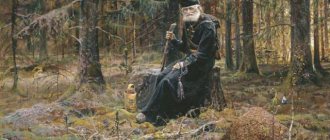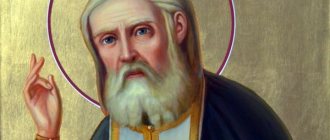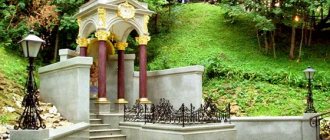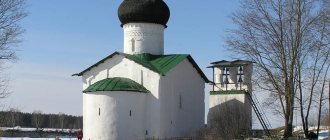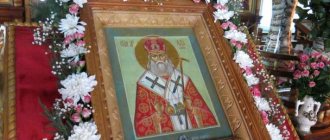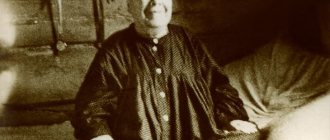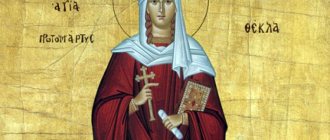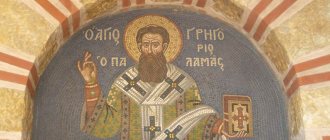Macarius Kalyazinsky founder of the monastery
For several years, the neophyte monk surprised the brethren with his humility and zeal in obedience, but soon the busy (no more than a mile from the city center) monastery began to weigh on him. And so in the mid-1430s, Macarius Kalyazinsky went to look for his desert. He went a couple of dozen miles, to the place where Kalyagin is now, or rather, where the flooded part of Kalyazin is now. There he built himself a cell. Soon he was joined by several more Klobuk elders who were inclined to live in the desert.
But the trouble is, the “desert,” as it turned out, had an owner. Boyar Ivan Kolyaga. He didn’t like the fact that monks settled on his land, and he decided, no less, to kill Macarius of Kalyazinsky. But, before he had time to move from thought to action, he fell seriously ill. Not everything was lost in the boyar’s soul, he realized for what sins, or rather, from what sin the Lord was saving him... Kolyaga personally went to ask for forgiveness from Macarius, repented of his villainous thoughts to him, and in response - “God will forgive!” The boyar quickly got rid of the illness and, they say, then settled in the Makaryev Monastery, and gave his lands to the monastery, named after the landowner, “Kolyazinskaya” (Kalyazinskaya).
Living in the world
The Monk Macarius, in the world - Matvey, was born in the village of Gribkovo (later the village became known as Kozhino), 198 versts from Tver, near the city of Kashin. Until the middle of the 16th century. there was a wooden church in Kozhin; It is believed that Matvey was baptized in it and he got married there. Vasily and Irina Kozhin had four children: Matvey, Alexander, Grigory, Ksenia.
Alexander became the only one who continued the Kozhin family. Gregory (monastically Gennady) was the archimandrite of the legendary Otroch Monastery in Tver, and in 1461-1477. - Bishop of Tver. Daughter Ksenia married Ivan Ivanovich Gavrenev, a Uglich boyar. The date of birth of the Kozhins’ eldest son, Matvey, is said to be 1400 or 1402.
The nobles of Kozhina descended from a native of the Holy Roman Empire (or from Sweden), who was an ambassador, but later found himself in the Russian service; in Orthodox baptism he had the name Anania. His son, Vasily Ananievich, received the nickname Kozha, according to family legend, for his victory over Dmitry Shemyaka in 1450. He allegedly overtook Shemyaka and killed a horse under him, from which he cut out a piece of leather in memory of that. For this feat, Vasily was granted the dignity of the Russian nobility.
The Kozhins prepared their eldest son Matvey for military service. Matvey loved to spend time reading spiritual books - he was not keen on games, and in his soul he constantly offered up dear prayers, psalms and spiritual songs, trying to serve God as much as possible. When he began to reach adulthood, he decided to retire from worldly vanity. However, having fulfilled the will of his parents, Matvey got married.
His wife, Elena Yakhontova, was the niece of the boyar and butler of the Tver Grand Duke Mikhail Alexandrovich. After Matvey’s parents died, and then his wife, with whom he agreed not to enter into a second marriage in the event of the death of one of them, he went to a monastery. “And he, having been married for only three years, around 1420, distributed all his property to the poor, and took monastic vows with the name Macarius, in the Nikolaev Klobukov Monastery in the city of Kashin.”
(It is interesting that on the Tver land there are several monasteries that have telling names or nicknames. Thus, the Kashin Klobukov Monastery has such an unusual name, since an ancient legend says that the Novgorod Archbishop John, flying on a demon to Jerusalem, lost his monastic hood over this area The Otroch Monastery , mentioned above, was founded by an Otroch, a young servant of Prince Yaroslav Yaroslavich, who was forced to part with his beloved by order of the prince, who wanted to marry the young beauty himself) .
Abbot Macarius Kalyazinsky
True, Macarius Kalyazinsky did not agree to become rector for a long time. Then he nevertheless gave in to the requests of the brethren, but still worked on an equal basis with everyone else. He wore such poor clothes that evil tongues called him “the Kalyazin peasant.” But this “man” healed the weak and possessed, and guided sinners onto the true path. They say that once robbers stole the monastery's oxen. However, they were unable to get far with the cattle - they suddenly became blind, got lost and got lost, and went back to the gates of the monastery, where Macarius was already waiting for them. The elder restored the sight of the kidnappers in exchange for a promise to never covet someone else's property again.
Macarius died in 1483. Shortly before his death, he was seriously ill, surrendered to silence, and only just before the end spoke again: he said goodbye to the brethren and ordered them to remain “always in work, fasting, vigil and unceasing prayer,” to maintain the purity of soul and body, and not to pay evil for evil.
Macarius of Kalyazin the Wonderworker
Macarius was buried in a wooden church, which he himself built. In 1521, the relics were found: instead of a dilapidated wooden church, the Kalyazin abbot ordered to build a stone one, blessed to dig the foundation and... The builders dug up a coffin untouched by decay, from which a fragrance emanated. They immediately recognized that this was the coffin of Elder Macarius... Soon miracles began from the relics - multiple healings, which began to attract pilgrims to the Kalyazin monastery, including royalty.

